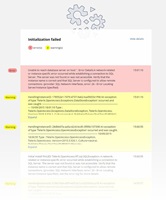Types of application status pages
When you upgrade your site or you initialize or startup the system, Sitefinity CMS displays the following types of status pages:
General status page
This page notifies the user for one of the following:
- In case of upgrade, it notifies that the site is currently unavailable due to maintenance.
- In case the site is initializing, restarting, or down, it notifies that the site will be back shortly.
Detailed status page
This mode gives all log information to the user in case of upgrading. The application status page is not automatically redirected when the upgrade succeeds of fails, giving the chance to the user to review all the logs. In case the site is initializing and there is a failure, the application status page gives all the available log information to the user to check the problem. In case site starts successfully, user is automatically redirected to originally requested URL.
The detailed status page is generated based on the logging categories - ConfigurationPolicy.UpgradeTrace and ConfigurationPolicy.ErrorLog. It does not read any data from the UpgradeTrace.log and the Error.log files.
The detailed page displays the following information about the bootstrap and upgrade processes:
- Schema migration complexity:
- Trivial - contains schema artifacts without influencing the existing schema
- Extending - contains schema artifacts that extend the existing schema
- Complex - contains schema artifacts with structural changes
- Types of the schema changes:
- Adding columns, constraints, indices, etc. to existing tables
- Adding tables
- Modifying columns or existing structures
- Removing columns, constraints, indices from existing tables
- Using temporary tables to migrate data during structural table changes
- The prepared schema migration statements
- More specific start-up and upgrade system information:
- Upgrade from and to build versions
- Updating configuration settings
- Changes in namespaces and assemblies
- Adding backend pages
- Cleaning up of unused subscriptions
- Adding columns for added new languages
- Adding tables for created new dynamic modules
- Specific modules changes
EXAMPLE: The following screenshot is an example of the detailed information, displayed in the detailed status page after the site initialization has failed:

Status page location
The detailed and the general status pages are displayed using an HTML page created in the AppData folder of your Sitefinity CMS application. This page is reused during later system startups and upgrades:
~/App_Data/appStatusReport.html
If you are using an Internet Explorer 9 or below, a different HTML page is created and used. It is not an AngularJS application, but simpler one. This page mimics the behavior of the appStatusReport.html. The difference is due to the support of AngularJS in IE browsers with versions less than 10. The following page is created:
~/App_Data/appStatusSimple.html